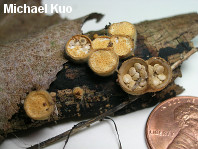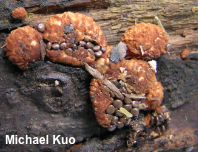Key to 31 Bird's Nest Fungi in North America
| 1. | Fungus shaped like a ball or a glob without a distinct "lid"; breaking up irregularly at maturity to expose a pile of "eggs." | 2 |
| 1. | Fungus shaped roughly like a cup or goblet that is covered with a "lid" when young (though the lid often disappears quickly); "eggs" held in a nest-like receptacle at maturity. | 6 |
| 2. | Nest fairly dark in color (dark buff to some shade of brown); nest wall granular to fuzzy; spinose hyphae present in nest wall (illustration). | 3 |
| 2. | Nest pale (whitish to pale yellowish); nest wall smooth, without spinose hyphae. | 4 |
| 3. | Eggs brown (grayish brown to reddish brown), shiny, shape ranging from platelet-like to lozenge-like or lens-like, not becoming wrinkled when dried for the herbarium; peridiole walls composed of fused, inseparable hyphae. | |
| 3. | Eggs reddish brown, dull, lens-shaped, becoming wrinkled when dried; peridiole walls composed of separable hyphae. | Nidularia deformis |
| 4. | Eggs reticulate; distributed from the Gulf Coast southward. | Mycocalia reticulata |
| 5. | Eggs chestnut brown; recorded from British Columbia. | Mycocalia denudata |
| 5. | Eggs dark blood red to blackish; recorded from the east coast of the United States. | Mycocalia duriaeana |
| 6. | Outer surface and inner surface of nest fairly smooth to the unaided eye (ignore the surface of the "lid," when present, and the upper edge of the nest, which may or may not be hairy). | 7 |
| 6. | Outer surface and/or inner surface of nest shaggy, hairy, grooved, or velvety. | 10 |
| 7. | Eggs attached to the nest with tiny cords. | 8 |
| 7. | Eggs not attached with cords. | 9 |
| 8. | Nest yellowish to yellowish brown, typically wider than 3 mm across; widely distributed. | |
| 8. | Nest whitish to buff, typically smaller than 3 mm across; northern in distribution. | Crucibulum parvulum |
| 9. | Eggs mahogany brown; nest up to 6 mm high. | Nidula niveotomentosa |
| 9. | Eggs gray or light brown; nest up to 15 mm high. | Nidula candida |
| 10. | Inside surface of nest vertically lined or grooved. | 11 |
| 10. | Inside surface of nest not lined or grooved | 20 |
| 11. | Found in temperate North America (from the Gulf Coast northward). | 12 |
| 11. | Found in tropical and subtropical North America (from the Gulf Coast southward). | 14 |
| 12. | Nest with a deep brown ring around its rim; recorded from Alberta. | Cyathus annulatus |
| 12. | Not completely as above. | 13 |
| 13. | Nest typically 5-6 mm wide; montane and boreal in distribution. | Cyathus helenae |
| 13. | Nest typically 6-8 mm wide; widely distributed. | |
| 14. | Nest typically 3 mm wide or smaller; eggs black; recorded from Puerto Rico. | Cyathus costatus |
| 14. | Not completely as above. | 15 |
| 15. | Nest pale gray or buff; "lid" bright white with brownish tufts of hairs; recorded from Mexico. | Cyathus bulleri |
| 15. | Not completely as above. | 16 |
| 16. | Nest dark brown, tall and slender (to 15 mm high, 5-6 mm across); eggs large (3 mm thick); recorded from Costa Rica and Jamaica. | Cyathus gayanus |
| 16. | Not completely as above. | 17 |
| 17. | Eggs sheathed; all spore dimensions about 20 µm or smaller. | 18 |
| 17. | Eggs not sheathed; spores 30-42 x 20-28 µm. | Cyathus poeppigii |
| 18. | Eggs often triangular in shape; spores 18-20 x 8-10 µm. | |
| 18. | Eggs elliptical to round; spores variously sized. | 19 |
| 19. | Spores 20 x 12 µm. | Cyathus montagnei |
| 19. | Spores 6-9 x 4-7 µm. | Cyathus berkeleyanus |
| 20. | Outside surface of nest velvety or finely hairy, but not conspicuously shaggy, hairy, or scaly. | 21 |
| 20. | Outside surface of nest conspicuously shaggy, hairy, or scaly. | 26 |
| 21. | Eggs typically larger than 2 mm across. | 22 |
| 21. | Eggs typically 2 mm across or smaller. | 23 |
| 22. | Nest 10-15 mm high, 8-10 mm wide. | |
| 22. | Nest to 18 mm high and 15 mm wide. | |
| 23. | At least one sporal dimension regularly longer than 10 µm. | 24 |
| 23. | All sporal dimensions shorter than 10 µm. | 25 |
| 24. | Spores 12-22 x 10-12 µm; inner surface of nest silvery; tropical or subtropical in distribution. | Cyathus earlei |
| 24. | Spores 12-14 x 8-9 µm; inner surface of nest dark; recorded from the West Coast of the United States and from Chile. | Cyathus pygmaeus |
| 25. | Spores 7-9 µm; inner surface of nest white; tropical in distribution. | Cyathus canna |
| 25. | Spores 5-6 x 4 µm; inner surface of nest brownish; tropical or subtropical in distribution. | Cyathus microsporus |
| 26. | Eggs shiny and black, not sheathed; growing on dung or manured soil. | 27 |
| 26. | Eggs not shiny and black, sheathed; not growing on dung. | 28 |
| 27. | Nest golden brown darkening to blackish, 5-15 mm high; spores up to 40 µm long; widely distributed. | |
| 27. | Nest pale, less than 5 mm high; spores 8 x 16 µm; recorded from Mexico. | Cyathus fimicola |
| 28. | At least one sporal dimension regularly longer than 18 µm. | 29 |
| 28. | All sporal dimensions shorter than 18 µm. | 30 |
| 29. | Nest dark buff; spores 16-22 x 12-14 µm. | Cyathus triplex |
| 29. | Nest dark purple brown to black; spores 17-24 x 10-14 µm. | Cyathus setosus |
| 30. | Spores longer and/or wider than above. | 31 |
| 31. | Nest pale buff, with a very narrow base; spores 7-15 x 4-9 µm. | Cyathus pallidus |
| 31. | Nest pale fawn to rusty, without a conspicuously narrowed base; spores 10 x 16 µm. | Cyathus intermedius |
References
Baseia, I. G. & A. I. Milanez (2001). Nidularia pulvinata (Schwein.) Fries (Gasteromycetes): a new record from Brazil. Revista Brasileira de Botânica 24: 479–481.
Brodie, H. J. (1950). Notes on two little known bird's nest fungi from southern United States. Mycologia 42: 186–190.
Brodie, H. J. (1952). Interfertility between two distinct forms of Cyathus olla. Mycologia 44: 413–423.
Brodie, H. J. (1967). New record of a large Cyathus from western Canada. Mycologia 59: 532–533.
Brodie, H. J. (1975). The bird's nest fungi. Canada: University of Toronto Press. 199 pp.
Cejp, K. & J. T. Palmer (1963). The genera Nidularia Fr. and Mycocalia J. T. Palmer in Czechoslovakia and Mycocalia sphagneti J. T. Palmer sp. nov. from England. Česká Mykologie 17: 113–126.
Coker, W. C. & J. N. Couch (1928). The Gasteromycetes of the eastern United States and Canada. North Carolina: University of North Carolina Press. 201 pp.
Cortez, V. G., I. G. Baseia & R. T. Guerrero (2006). Additions to the mycobiota (Agaricales, Basidiomycetes) of Rio Grande do Sul, Brazil, II: The bird's nest fungus Nidularia pulvinata (Schwein.) Fr. Biociências 14: 15–18.
Cortez, V. G., I. G. Baseia & R. M. B. da Silveira (2014). Gasteroid mycobiota of Rio Grande do Sul, Brazil: Nidulariaceae. Acta Biológica Paranaense 43: 1–21.
Gómez, C. L. & E. Pérez-Silva (1988). Especies de Nidulariales (Gasteromycetes) comunes en México. Revista Mexicana de Micología 4: 161–183.
Johnson, M. M. (1929). The Gasteromycetae of Ohio: puffballs, birds'-nest fungi and stinkhorns. Ohio Biological Survey Bulletin 22, Vol. 4: 271–352.
Kraisitudomsook, N., R. A. Healy & M. E. Smith (2021). Molecular systematics and taxonomic overview of the bird's nest fungi (Nidulariaceae). Fungal Biology 125: 693–703.
Trierveiler-Pereira, L. & I. G. Baseia (2013). Cyathus species (Basidiomycota: Fungi) from the Atlantic Forest of Pernambuco, Brazil: taxonomy and ecological notes. Revista Mexicana de Biodiversidad 84: 1–6.
White, V. S. (1902). The Nidulariaceae of North America. Bulletin of the Torrey Botanical Club 29: 251–280.
Zhou, T. X., L. Z. Zhao, R. L. Zhao & Y. H. Chen (2004). Bird's nest fungi from China. Fungal Diversity 17: 243–251.
This site contains no information about the edibility or toxicity of mushrooms.
Cite this page as:
Kuo, M. (2014, February). The bird's nest fungi. Retrieved from the MushroomExpert.Com Web site: http://www.mushroomexpert.com/birdsnests.html
© MushroomExpert.Com


